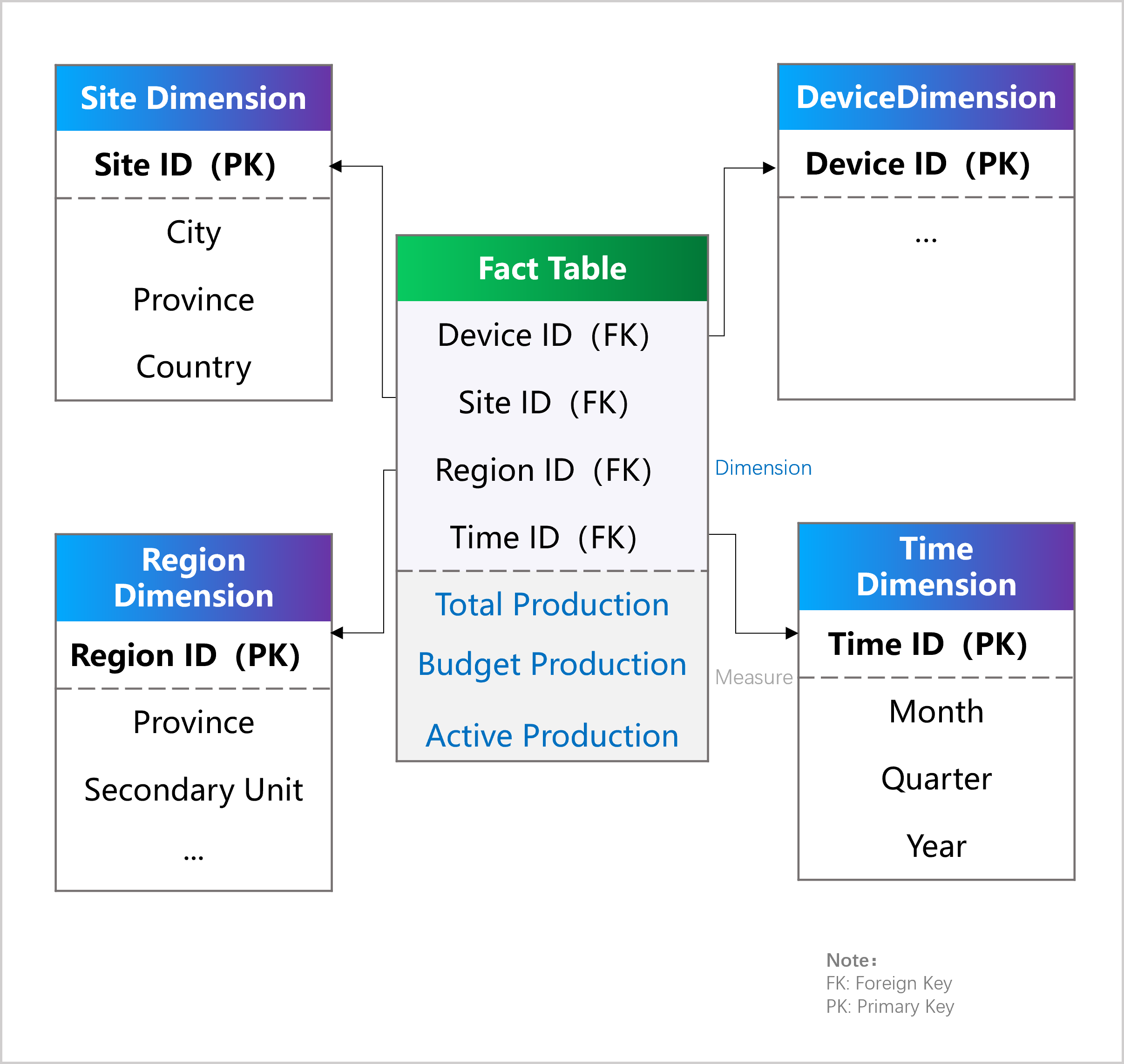Key Concepts¶
The users and permissions of EnOS Metric Management are inherited from EnOS Application Portal. Before starting, you should learn about the key concepts of EnOS Application Portal.
Below are the key concepts of Metric Management.
Dimension Modeling¶
Dimension modeling is a data modeling method in database construction. Dimension modeling tries to use intuitive standard framework structures to represent data and enable high-performance access. Metric Management can help users quickly access and analyze data by designing models for different business scenarios based on dimension modeling. The basic structure of dimension modeling is as follows:

Among which:
The fact table stores fact records and is the core of dimensional modeling, including linked dimensions and measurements related to business processes,
Dimension tables are associated with fact tables and are used to extract and store recurring attributes of fact tables.
Dimensions¶
Dimensions are perspectives used to observe and analyze business data. For example, “geographic dimension”, which includes countries, regions, provinces, and city levels.
Dimension Tables¶
Dimension tables are used to store dimension-based attribute data, which supports data aggregation, drill-down, and slice analysis, and can be used in GROUP BY conditions in SQL statements. For example, “Xinjiang branch” and “EnOS wind turbines” in “Active generation of all EnOS wind turbines at Xinjiang branch” can be created as a regional dimension table and a manufacturer dimension table respectively.
Dimension Tasks¶
A dimension task is a task for synchronizing dimension data. When the data of the dimension table is synced from Data Catalog or database, and the dimension configuration is published, a dimension task will be created.
Dimension Task Instances¶
Every time a dimension task is synchronized at the set time, a dimension task instance will be generated.
Facts¶
Facts refer to specific physical activities that occur during a business process. For example, on June 1, 2022, the production of a wind turbine with device ID AAAAA in site A101 is 10000 kWh.
Fact Tables¶
A fact table usually consists of dimension foreign keys and measurements, and is a table that records business process details or contains all facts. Each row of the fact table corresponds to a business event, and each database contains one or more fact tables.
Associated Dimensions¶
An associated dimension is a foreign key field in the fact table that is associated with the dimension table. For example, “site ID” is the foreign key associated with the fact table and the dimension table of site.
Measurements¶
Measurements refer to fields in the fact table that can be aggregated, and are generally numeric data. For example, “production” is a measurement in the fact table.
Metrics¶
Metrics are statistical data that are of reference value to the current business.
Atomic Metrics¶
Atomic metrics are abstracted from business logic that cannot be further subdivided. Atomic metrics define the acquisition and calculation logic of values under business activities, and are also the basis for derived metrics and compound metrics. Atomic metrics are composed of aggregators and business meanings. For example, “cumulative production”, where “cumulative” represents the aggregator, and “production” represents the business meaning.
Derived Metrics¶
Derived metrics are composed of atomic metrics, time periods, and statistical dimensions, and are used to count and analyze the metrics of a certain business situation in business activities. Atomic metrics provide the statistical scope for derived metrics. For example, “the cumulative generation of EnOS wind turbines in the last 30 days”, in which “cumulative generation” represents the atomic metric, “last 30 days” represents the time period, and “EnOS turbine” represents the statistical dimension.
Compound Metrics¶
Compound metrics are calculated by superimposing one or more derived metrics. The statistical dimensions and periods of compound metrics carries over from the derived metrics, and the statistical scope carries over from the atomic metrics associated with the derived metrics. For example, the compound metric of “Year-on-year increase in cumulative generation of EnOS Wind turbines in 2022” can be calculated from the derived metric of “Cumulative generation of EnOS wind turbines in the last 30 days”.
Single-Valued Metrics¶
A derived metric or compound metric with only one fixed value corresponding to it. For example, “the amount of power generated by a device on a given day”.
Multi-Valued Metrics¶
A derived or compound metric with more than one value corresponding to it. For example, “the amount of electricity generated by a device per day”.